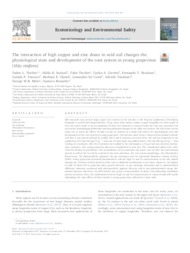The interaction of high copper and zinc doses in acid soil changes the physiological state and development of the root system in young grapevines (Vitis vinifera).
The interaction of high copper and zinc doses in acid soil changes the physiological state and development of the root system in young grapevines (Vitis vinifera).
Autoria: TIECHER, T. L; SORIANI, H. H.; TIECHER, T.; CERETTA, C. A.; NICOLOSO, F. T.; TAROUCO, C. P.; CLASEN, B. E.; DE CONTI, L.; TASSINARI, A.; MELO, G. W. B. de; BRUNETTO, G.
Resumo: Old vineyards may present high copper (Cu) content in the soil due to the frequent application of Bordeaux fungicide to control leaf fungal diseases. Thus, many wine makers replace copper fungicides by those made of zinc (Zn) and it leads to the accumulation of these two elements in vineyard soils, fact that may potentiate the occurrence of physiological disorders and morphological changes in the plant root system. The aim of the current study was to assess the effects of high Cu and Zn contents in a sandy acid soil on the physiological state and development of the root system in young grapevines. The soil was taken from a vineyard from Southern Brazil, and then it was sieved and had its acidity and P and K contents corrected. Next, the soil was subjected to the application of 0 and 120 mg Cu kg?1 ; each one of these doses was added with 0, 120 and 240 mg Zn kg?1 , thus totaling six treatments. After the treatments were added to the soil samples, 2.4 kg of soil was stored in rizoboxtype containers. One young grapevine plant was transplanted to each box. The transplanted plants were cultivated for 60 days in greenhouse. The accumulation of root and shoot dry matter was set after the experimental period, as well as the Cu and Zn contents in the roots and shoot, the root system morphology, the chlorophyll a fluorescence, the photosynthetic pigments, the gas exchanges and the superoxide dismutase enzyme activity (SOD). Young grapevines presented mechanisms to tolerate high Cu and Zn concentrations in the soil, mainly through the retention of such metals in their roots to diminish translocation to the shoot. However, the highest Cu and Zn doses led to grapevine plant growth decrease, to gas exchange alterations and to photochemical efficiency reduction associated with photosynthetic pigment decrease and to non-photochemical energy dissipation increase. Moreover, the SOD activity was greater in intermediate Zn doses, thus indicating antioxidant system activation. Thus, the combination between high Cu and Zn concentrations in vineyard soils will enable minimizing the toxic effects of these metals to young grapevines cultivated in these soils. Keywords: Vineyard soils Gas exchange Chlorophyll fluorescence Root system Photosynthetic pigments Heavy metals
Ano de publicação: 2018
Tipo de publicação: Artigo de periódico
Unidade: Embrapa Uva e Vinho
Observações
1 - Por padrão são exibidas publicações dos últimos 20 anos. Para encontrar publicações mais antigas, configure o filtro ano de publicação, colocando o ano a partir do qual você deseja encontrar publicações. O filtro está na coluna da esquerda na busca acima.
2 - Para ler algumas publicações da Embrapa (apenas as que estão em formato ePub), é necessário ter, no celular ou computador, um desses softwares gratuitos. Sistemas Android: Google Play Livros; IOS: iBooks; Windows e Linux: software Calibre.
Acesse outras publicações
Acesse a Base de Dados da Pesquisa Agropecuária (BDPA) para consultar o acervo completo das bibliotecas da Embrapa.

